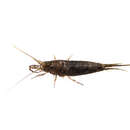en
names in breadcrumbs


The Machilidae are a family of insects belonging to the order Archaeognatha (the bristletails). There are around 250 described species worldwide. These insects are wingless, elongated and more or less cylindrical with a distinctive humped thorax and covered with tiny, close-fitting scales. The colour is usually grey or brown, sometimes intricately patterned. There are three "tails" at the rear of the abdomen: two cerci and a long central epiproct. They have large compound eyes, often meeting at a central point. They resemble the silverfish and the firebrat, which are from a different order, Zygentoma.
Machilids undergo virtually no metamorphosis during their life cycles, and both nymphs and adults are generally inconspicuous herbivores and scavengers. Many species are restricted to rocky shorelines, but some are found in well-vegetated habitats inland. They can move very fast and often escape by jumping considerable distances when disturbed.
Like all Archaeognatha, machilids transfer sperm indirectly from male to female. Some species can spin silken threads that lead the female to the spermatophore. Other species can produce silken stalks on which they place droplets of sperm.
There are no aquatic species, but some littoral forms, such as Parapetrobius and Petrobius, can swim.[1]
Their fossil records extends back into the Triassic with the genus Gigamachilis from the Middle Triassic of Italy and Switzerland, around 240 million years old.[2][3]
The Machilidae are a family of insects belonging to the order Archaeognatha (the bristletails). There are around 250 described species worldwide. These insects are wingless, elongated and more or less cylindrical with a distinctive humped thorax and covered with tiny, close-fitting scales. The colour is usually grey or brown, sometimes intricately patterned. There are three "tails" at the rear of the abdomen: two cerci and a long central epiproct. They have large compound eyes, often meeting at a central point. They resemble the silverfish and the firebrat, which are from a different order, Zygentoma.
Machilids undergo virtually no metamorphosis during their life cycles, and both nymphs and adults are generally inconspicuous herbivores and scavengers. Many species are restricted to rocky shorelines, but some are found in well-vegetated habitats inland. They can move very fast and often escape by jumping considerable distances when disturbed.
Like all Archaeognatha, machilids transfer sperm indirectly from male to female. Some species can spin silken threads that lead the female to the spermatophore. Other species can produce silken stalks on which they place droplets of sperm.
There are no aquatic species, but some littoral forms, such as Parapetrobius and Petrobius, can swim.
Their fossil records extends back into the Triassic with the genus Gigamachilis from the Middle Triassic of Italy and Switzerland, around 240 million years old.